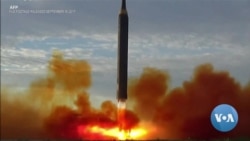North Korean state media have reported the country’s test of an intermediate range ballistic missile, Pyongyang’s longest-range missile test in more than four years.
The Korean Central News Agency (KCNA) said the test was meant to verify the accuracy of the Hwasong-12 missile launched early Sunday from a northwest region.
State media showed pictures not only of the missile emerging from a mobile launcher in a wooded area, but also two photos looking back at Earth, taken by a camera attached to the warhead after it had reached outer space.
South Korea’s military earlier said the missile reached a maximum altitude of about 2,000 kilometers, flying at a steep angle, before splashing down about 800 kilometers away from the launch site.
North Korea used the lofted trajectory “in consideration of the safety of neighboring countries,” according to the Monday KCNA report.
WATCH: North Korea tests an intermediate range ballistic missile
North Korean missile launches have at times passed over Japan, prompting outrage from Japanese leaders.
The Hwasong-12 has a maximum range of about 4,500 kilometers, according to defense analysts.
It is the longest-range missile North Korea has tested since 2017, when it launched two intercontinental ballistic missiles during the height of tensions between North Korean leader Kim Jong Un and then-U.S. President Donald Trump.
Although the move will likely be viewed as a provocation by many in Washington, North Korean state media did not cover it as such.
The brief KCNA report on Monday contained none of the bombastic, anti-U.S. language that often accompanied major North Korean launches in 2017.
The launch, in fact, was not even covered on the front page of the Rodong Sinmun, North Korea’s ruling party newspaper.
Analysts say North Korea has tried to convey a sense of normalcy about its launches in an attempt to be treated like any other country developing its own weapons.
North Korea, however, is prohibited from any ballistic missile activity by a series of United Nations Security Council resolutions.
That has not deterred launches. So far in January, North Korea has launched 11 missiles, setting a new monthly record.
In a statement, the U.S. military’s Indo-Pacific Command condemned the test and called for North Korea to refrain from further destabilizing acts.
In a statement, South Korean President Moon Jae-in said the launch takes North Korea a step closer toward making good on its threat to abandon its voluntary suspension of longer-range missile tests.
Japan’s chief Cabinet secretary, Hirokazu Matsuno, also strongly condemned the launch.
North Korea's missile frenzy appears at least partly aimed at pressuring the United States and South Korea amid an extended pause in nuclear talks. North Korea has several other possible motivations for testing missiles, including shoring up domestic political support for leader Kim, ensuring the performance of new weapons and demonstrating deterrence.







